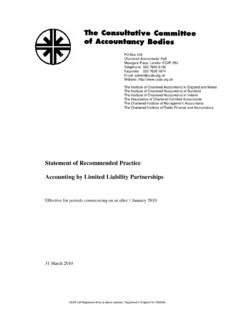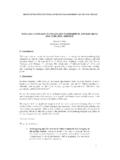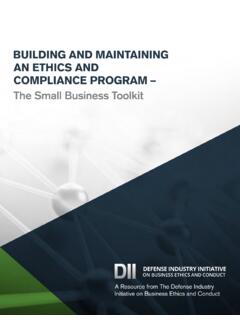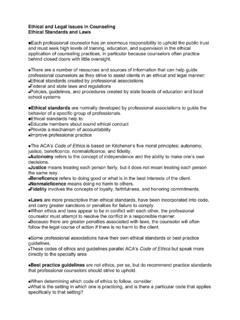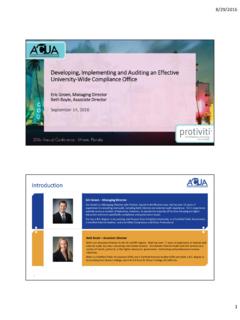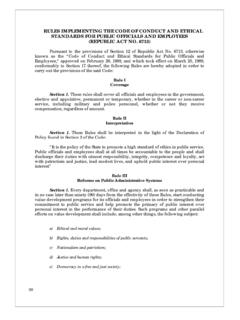Transcription of DEVELOPING AND IMPLEMENTING A CODE OF …
1 DEVELOPING AND IMPLEMENTING A code OF ETHICAL CONDUCTA GUIDE FOR BUSINESSES AND OTHER ORGANISATIONSJ anuary 2014 CCAB 20141. The Purpose of this Why Codes of Ethical Conduct Are How to Use This SCOPE OF A code OF ETHICAL To Whom Does the code Apply?.. The Objectives of a code of Ethical ELEMENTS OF A code OF ETHICAL Mission High-Level Ethical Specific CONSTRUCTING AN EFFECTIVE code OF ETHICAL EMBEDDING AND SUPPORTING A code OF ETHICAL Development and Approval Introducing the code to the Internal Use of Case New Managers and Performance Tone at the Access to Whistle-blowing/Speak up Obligations and The Role of the Professional MONITORING AND Ongoing Periodic 1: STRUCTURE FOR A code OF ETHICAL 2.
2 OTHER SOURCES OF on Codes of Ethical Tools and AND IMPLEMENTING A code OF ETHICAL CONDUCT1. INTRODUCTIONAn organisation s code of ethical conduct provides guidance and support to individuals for making decisions and carrying out their work in ways that are compatible with the organisation s values. In order for a code of ethical conduct to be effective, it must be promoted and championed throughout the organisation. Managers and staff, at all levels, must be provided with the necessary training and support, and the code itself must be supported by appropriate disciplinary and whistle-blowing/speak up procedures.
3 The tone at the top must permeate through the organisation and the code must be owned by The Purpose of this GuidanceIt is not difficult to recall a number of high-profile corporate scandals reported in the early part of this century (Tyco, WorldCom, Enron, Parmalat ..). More recently, the financial crisis has turned the spotlight once more on integrity within the business community, with irregularities coming to light within organisations such as Lehman Brothers, Olympus Corporation and even some of the major banks. Doubtless these organisations all had codes, but they were ineffective in isolation.
4 The values and principles within those codes had not been successfully embedded within the is pleased to publish DEVELOPING and IMPLEMENTING a code of Ethical Conduct. This guidance is intended to assist professional accountants who are seeking to develop or enhance codes of conduct within their organisations be they in business, the public sector or the third sector. Equally, it is intended to suggest ways of effectively supporting a code and embedding its values and principles within the organisation. Where an organisation does not already have a formal code , a professional accountant within the organisation (or otherwise associated with it) may be central to the development and implementation of a code , whether or not the professional accountant is directly responsible for to an organisation s code is a useful mechanism when seeking to resolve ethical The code and its supporting systems are also of value at other stages of ethical decision-making, including enhancing ethical awareness at an early stage.
5 In DEVELOPING this guidance, CCAB is aware that professional accountants responding to the need for a code in their organisations might not have experience of DEVELOPING and IMPLEMENTING codes of ethical conduct. This guidance is not intended to be prescriptive, and it does not provide a template to be used in any organisation. Although Appendix 1 proposes a structure for an organisation s code of ethical conduct, each organisation is different, and the guidance should be read with this in Why Codes of Ethical Conduct Are ImportantThe primary purpose of a code of ethical conduct is to provide an organisation with a clear benchmark for ethical behaviour.
6 It sets out expected values and behaviours, alongside which a mechanism may be established for reporting variances from those expected standards . In addition, the introduction of a code helps build a values-driven organization 1 See Ethical Dilemmas Case Studies, published by CCAB at AND IMPLEMENTING A code OF ETHICAL CONDUCTand typically deals with an organization s underlying values, commitment to employees, standards for doing business, and its relationship with wider society .2A code of ethical conduct may be seen as a contract among all those within the organisation, as well as a statement to third parties concerning the standards they might expect of the organisation and those within it and associated with it.
7 There may also be pressure from certain stakeholders who wish to conduct business within an ethical well as providing a reference point within a disciplinary process, and a clear statement of the standards of behaviour expected, a code of ethical conduct is a tool available to the organisation for actually influencing the behaviour of employees, management, subcontractors and others. It forms a component of a system that aims to internalise ethical behaviour. Benefits may even be derived from employees who, on leaving the organisation, will be inclined to speak more favourably of the organisation and its effective introduction of a code will be of value to a wide range of stakeholders.
8 (There is little doubt that an effective code helps to protect the corporate reputation among stakeholders. But with a wide range of stakeholder interests in mind, the creation and implementation of a code of ethical conduct should take place with due regard for the public interest.) Therefore, a code of ethical conduct must have relevance to, and communicate effectively with: employees and subcontractors of the organisation directors and those charged with governance customers and suppliers agents of the organisation third party strategic partners investors and the wider business community others engaging with a public sector or charitable organisation members of the general public who may wish to engage with the organisation in the How to Use This GuidanceThis guidance is written in general terms.
9 Ultimately, a code of ethical conduct belongs to the organisation in question and, therefore, it should be specifically tailored to the needs of that organisation. This guidance should not be addressed with a view to incorporating every element of the guidance into a code . The key is to keep the code simple and issuing this guidance, CCAB is seeking to raise awareness of codes in organisations in which a professional accountant has influence. While the guidance is intended to be relevant internationally, it is not directed at multinational organisations. In the case of a small family business, for example, a single page code may be appropriate making staff and third 2 International Federation of Accountants, Defining and DEVELOPING an Effective code of Conduct for Organisations, June 20074 DEVELOPING AND IMPLEMENTING A code OF ETHICAL CONDUCT parties aware of the business s values, principles and policies.
10 This guidance is relevant to commercial organisations, the public sector, charities and professional firms. As such, it supports the existing ethical case studies published by starting to develop a code of ethical conduct, the following questions should be considered: Has the organisation established an agreed set of values and a set of ethical principles? Can these values and principles be expected to:oprevent the development or acceptance of unethical practices?opromote and maintain confidence in, and enhance the reputation of, the organisation?omake a positive contribution to the welfare of those within the organisation and in the wider community?



